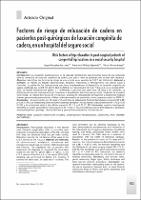| dc.contributor.author | Gonzales-Martínez, Jorge | |
| dc.contributor.author | Vílchez-Quevedo, Francisco | |
| dc.contributor.author | Torres-Anaya, Víctor | |
| dc.date.accessioned | 2023-06-06T19:56:23Z | |
| dc.date.available | 2023-06-06T19:56:23Z | |
| dc.date.issued | 2019-01-24 | |
| dc.identifier.citation | Revista del Cuerpo Médico Hospital Nacional Almanzor Aguinaga Asenjo. 2018:11(2). | es_PE |
| dc.identifier.uri | https://hdl.handle.net/20.500.12959/3853 | |
| dc.description.abstract | Introducción: La reluxación postquirúrgica, es la segunda complicación más frecuente luego de una reducción abierta correctiva de luxación congénita de cadera, por qué y cómo se producen aún no han sido resueltos. Objetivo: identificar los factores de riesgo de este evento en el servicio de C.O.T. del H.B.A.A.A. Material y métodos: se realizó un estudio Observacional, Analítico, Transversal y Retrospectivo; con diseño Casos y Controles. La población fue todo paciente que fuera intervenido por el diagnostico de Luxación congénita de cadera codificado por los CIE-10: Q65,0, Q65,1 o Q65,2 en el servicio de C.O.T. del H.B.A.A.A. en el periodo 2010 – 2015, se realizó muestreo por Epidat 3.1, ordenando 2 controles por cada caso: 28 casos y 56 controles. La definición de caso fue todo paciente perteneciente a la población descrita y que presenta reluxación de la cadera intervenida. Se realizó descripción de frecuencias, pruebas de contrastación de hipótesis y finalmente modelos lineales generalizados para calcular el Odds-ratio como medida de asociación, con el paquete estadístico STATA 13. Resultados: Se logró contar con 26 casos y 51 controles, la osteotomía femoral Desrotatoria presenta OR 2,88; p<0,05 IC:95%; las osteotomía femorales Desrotatoria y Varizante en una misma cirugía presentan OR 1,75; p>0,05 IC:95% y la osteotomía pélvica tipo Klissic presenta OR 1.5; p>0,05 IC: 95% Conclusión: nuestra investigación identifica en orden descendente como factores de riesgo: el uso osteotomía femoral Desrotatoria y Varizante, osteotomía pélvica tipo Dega , técnica de Klissic y procedimiento de retiro total del labrum. | es_PE |
| dc.description.abstract | most frequent complication after a corrective open
reduction of congenital dislocation of the hip, why and
how they are produced have not yet been solved,
Objective: identify the risk factors of this event in the
C.O.T. service of the H.A.A.A. Material and methods:
An observational, analytical, transverse and
retrospective study was carried out; With design Cases
and Controls. The population was all patients who
underwent the diagnosis of congenital hip dislocation
coded by the ICD-10: Q65.0, Q65.1 or Q65.2 in the
C.O.T. service of the H.A.A.A. In the period 2010-2015,
sampling was performed by Epidat 3.1, ordering 2
controls for each case: 26 cases and 51 controls. The
case definition was all patients belonging to the
described population and presented with reluxation of
the intervened hip. Frequency description, hypothesis
testing, and finally generalized linear models were
used to calculate the Odds ratio as a measure of
association with the STATA 13 statistical package.
Results: It was possible to count on 26 cases and 51
controls, the femoral osteotomy Desrotatoria presents
OR 2.88; P <0.05 IC: 95%; The femoral osteotomy and
the Varizante in the same surgery present OR 1.75; P>
0.05 CI: 95% and Klissic type pelvic osteotomy presents
OR 1.5; P = 0.05 CI: 95% Conclusion: our research
identifies in descending order as risk factors: the use of
femoral osteotomy, desrotatory and varicose veins,
pelvic osteotomy, Degas type, Klissic technique and
total labrum removal procedure. Conclusion: our
research identifies in descending order as risk factors:
the use of desrotatory femoral and / or varus femoral
osteotomy, Dega or Klissic type pelvic osteotomy and
total labrum removal procedure. | es_PE |
| dc.format | application/pdf | es_PE |
| dc.language.iso | spa | es_PE |
| dc.publisher | Seguro Social de Salud (EsSalud) | es_PE |
| dc.relation.uri | http://cmhnaaa.org.pe/ojs/index.php/rcmhnaaa/article/view/73 | es_PE |
| dc.rights | info:eu-repo/semantics/openAccess | es_PE |
| dc.rights.uri | https://creativecommons.org/licenses/by-nc-sa/4.0/ | es_PE |
| dc.subject | Luxación congénita de la cadera | es_PE |
| dc.subject | Complicaciones posoperatorias | es_PE |
| dc.subject | Osteotomía | es_PE |
| dc.subject | Perú | es_PE |
| dc.subject | Hip dislocation | es_PE |
| dc.subject | Congenital | es_PE |
| dc.subject | Postoperative complications | es_PE |
| dc.subject | Osteotomy | es_PE |
| dc.title | Factores de riesgo de reluxación de cadera en pacientes post-quirúrgicos de luxación congénita de cadera, en un hospital del seguro social | es_PE |
| dc.title.alternative | Risk factors of hip relaxation in post-surgical patients of congenital hip luxation, in a social security hospital | es_PE |
| dc.type | info:eu-repo/semantics/article | es_PE |
| dc.subject.ocde | https://purl.org/pe-repo/ocde/ford#3.02.17 | es_PE |
| dc.identifier.doi | https://doi.org/10.35434/rcmhnaaa.2018.112.73 | |






